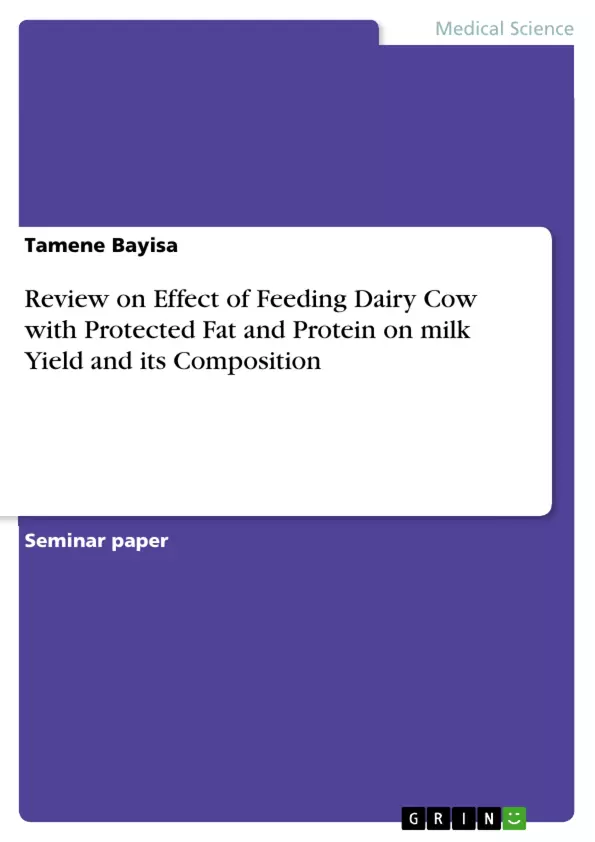Objective of this review is focus on effect of feeding protected fat and protected protein on milk yield and its composition and how these nutrients are protected. Many researchers in this review investigate that the responses are highly dependent on the type of fat and protein supplement and the stage of lactation. A higher milk response was observed with saturated than with unsaturated fat supplements. Diet with added fat increase milk production compared with a control diet without added fat in cows. Feeding of bypass fat resulted in significant increase in milk yield and Fat Corrected Milk yield particularly in early lactation. The source of Protected fat are (origin (animal, plant, processed or whole oilseeds, calcium salts) and Cereal Grains such as corn, wheat, Barly, oil seeds, sun flower, cotton seed, soybeans and canola). The supplementation of protected protein in the diets of lactating animals increases the milk yield due to proportionate increase in the supply of amino acids to the host postruminally Milk yield in cows fed protected methionine for the whole experimental period was numerically higher than in cows of the other groups. However, the difference was not statistically significant .At the centeral high land of Ethiopia the Treatment of shredded wheat and barley straw with urea, molasses, salt and water prior to feeding is a technology that should be considered . Cows with excessive body tissue mobilisation at this stage may take up to 20 weeks to regain a positive energy balance status.
Key words milk yield, composition ,protected fat , protein protected
Inhaltsverzeichnis (Table of Contents)
- Abstract
- Introduction
- Literature Review
- Effect of feeding Dairy cows with protected fat on milk yield
- Effect of protected fat on milk composition
- Sources of protected fat (By pass fat )
- Effect of feeding Dairy cows with protected protein on milk yield
- Effect of feeding Dairy cow with protected protien on milk composition
- Economic aspect of feeding protected protein to Dairy cow
- Methods of protein protection
- Formaldehyde treatment
- Heat treatment
- Using lateral flow device dipsticks
- Conclusion
- Recommendation
- References
- List of table
- List of Abrivation
Zielsetzung und Themenschwerpunkte (Objectives and Key Themes)
This review explores the impact of feeding protected fat and protein on milk yield and its composition in dairy cows. The review aims to understand how these nutrients are protected and how their supplementation affects milk production.
- Effect of protected fat and protein on milk yield and composition
- Methods of protecting fat and protein for optimal rumen bypass
- Factors influencing the effectiveness of protected fat and protein supplementation
- Economic considerations of feeding protected fat and protein to dairy cows
- The role of protected fat and protein in achieving optimal milk production
Zusammenfassung der Kapitel (Chapter Summaries)
- Abstract: This chapter provides a concise overview of the review's objectives, highlighting the focus on the effects of protected fat and protein on milk yield and composition, along with methods of protecting these nutrients. The abstract emphasizes the variability in responses based on fat and protein supplement types and lactation stages.
- Introduction: This chapter will likely introduce the importance of milk production in the dairy industry and discuss the role of fat and protein in achieving optimal milk yield and composition. It might also address the limitations of traditional feeding methods and highlight the potential benefits of protected fat and protein supplements.
- Literature Review: This section will likely delve into research findings related to the effects of feeding protected fat on milk yield and composition. It might explore different types of protected fat supplements, their impact on milk production, and the factors influencing their effectiveness. The review might also discuss the sources of protected fat, including animal, plant, and processed sources.
- Methods of protein protection: This chapter explores various methods used to protect protein from rumen degradation, ensuring its availability for absorption in the small intestine. It will likely discuss techniques such as formaldehyde treatment, heat treatment, and the use of lateral flow device dipsticks, highlighting their advantages and disadvantages.
Schlüsselwörter (Keywords)
This review focuses on the key terms and concepts of protected fat and protein in dairy cow feeding, including their effects on milk yield, composition, and economic aspects. The review examines the various methods of protecting these nutrients, highlighting their efficacy and applications in optimizing milk production.
- Quote paper
- Msc.Student Tamene Bayisa (Author), 2017, Review on Effect of Feeding Dairy Cow with Protected Fat and Protein on milk Yield and its Composition, Munich, GRIN Verlag, https://www.hausarbeiten.de/document/385881


